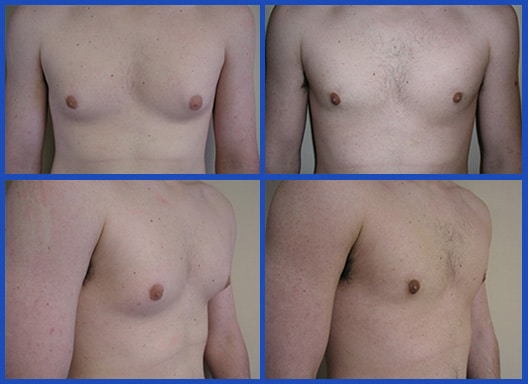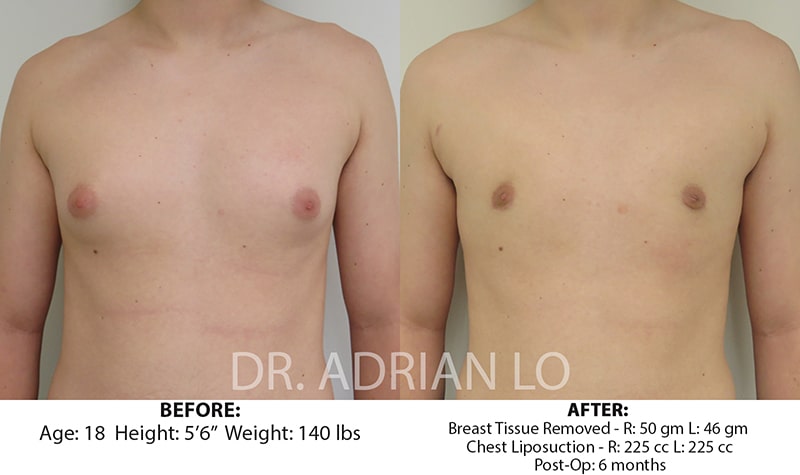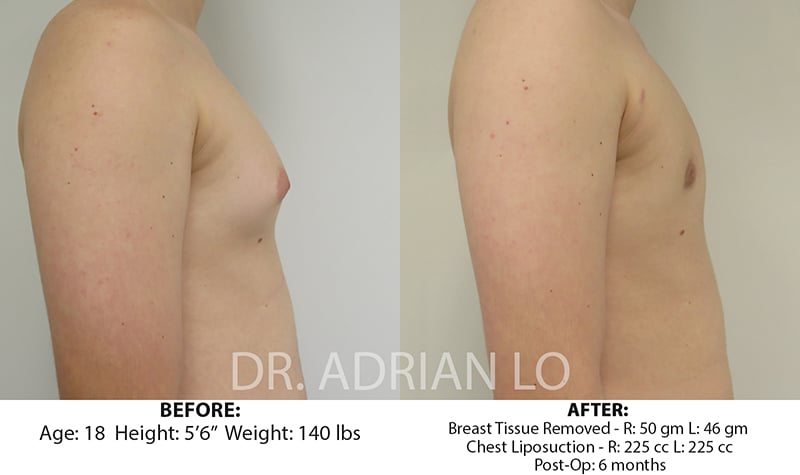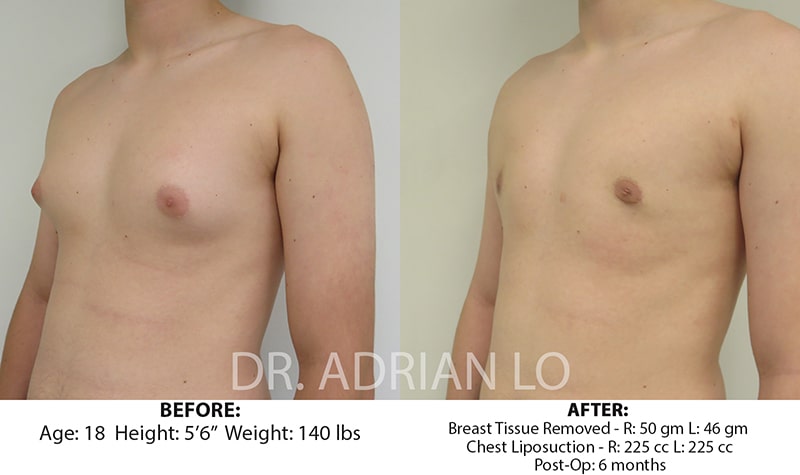Gynecomastia Surgery
For Teens
Many adolescents develop breast gland tissue or gynecomastia during puberty and their teenage years. The gynecomastia is usually permanent and does not resolve over time. This situation may lead to psychological issues and social withdrawal. Dr. Lo can remove the gynecomastia through surgery helping restore a teenager’s confidence with a normal looking chest.
Request A Consultation Before & AfterWhat Is Adolescent Gynecomastia?
Adolescent gynecomastia is a condition stimulated by a hormone imbalance causing the growth of breast tissue. Gland tissue starts growing in males when they are 10 to 13 years old during puberty, beginning about six months following the onset of secondary male traits.
- There is an imbalance of estrogen, the hormone that triggers gland tissue growth, and testosterone, the hormone that counteracts estrogen’s effect. This slight hormonal imbalance is very common and is enough to cause the growth of gland tissue resulting in gynecomastia.
- Gland tissue takes on a firm, fibrous nature once the males reach adulthood.
- The breast gland tissue frequently feels like a hard lump and can be tender or painful.
- Often there are puffy nipples and the areola is enlarged.
- While some males find that adolescent gynecomastia diminishes as they mature, the majority of males discover that their gynecomastia never gets better.
- Many are told by their doctor/pediatrician that the gynecomastia will “go away with time”. If this sounds familiar, you are not alone. A significant number of adolescent males diagnosed with gynecomastia are recommended gynecomastia correction surgery by Dr. Lo because their condition will most likely not get better.

I Am A Parent Of A Teenager With Gynecomastia. How Do I Know That He Is A Candidate For Gynecomastia Surgery?
Many teenage boys anxious about their gynecomastia or extra breast tissue may do research on their own to learn how to correct gynecomastia. They may be reluctant to tell their parents about their concerns regarding their chest appearance.
Your teen may be a candidate for gynecomastia surgery if he:
- Has enlarged breast tissue that has not resolved over time.
- Is uncomfortable in social situations, such swimming at the pool or beach or at gym class at school and never takes his shirt off.
- Is becoming psychologically affected by the gynecomastia.
Gynecomastia Surgery For Teens Faqs
-
Surgical removal of the breast gland is the only treatment for persistent gynecomastia in teenagers.
- Subcutaneous mastectomy is the surgical technique where Dr. Lo completely removes the enlarged breast tissue or gland.
- Liposuction sculpting may also be done at the same time to give you the best result possible.
- Puffy nipples will be corrected as well.
- Large areolas will become smaller and shrink to a more normal size with surgery.
-
Adolescent boys and men, especially if they are overweight, may experience pseudogynecomastia, a condition where there is extra fat tissue in the breast area causing enlarged breasts rather than enlarged breast glands.
- Dr. Lo treats this condition with one of his sophisticated liposuction techniques: tumescent, ultrasonic or power-assisted liposuction to remove the fat that is causing the enlarged breast.
- There may be a small amount of breast gland that will need to be removed. Dr. Lo performs subcutaneous mastectomy to remove the breast gland.
-
Male breast reduction surgery is required for severe cases of gynecomastia surgery.
- If you have severe man boobs with larger breasts that are a B cup, C cup, D cup size then you may need a male breast reduction surgery.
- Male breast reduction surgery involves making incisions or cuts completely around the nipple/areola to move it to a normal position. A cut in the lower chest/inframammary crease from side to side is used to remove breast tissue and skin.
-
- Dr. Lo will review all available options with you and your son and suggest a suitable surgical regimen during consultation.
- His caring patient coordinators will review all aspects of surgery, scheduling and costs and financing.
- Dr. Lo has given many teenage boys a normal-looking chest and restored their self-confidence.
Contact Us
For more information about the treatment for adolescent gynecomastia or to schedule a personal consultation with Dr. Lo, please contact his office by calling (215) 829-6900.
Contact Us
Schedule A ConsultationLocations
Philadelphia Cosmetic Surgery
301 South 8th Street, Suite 3H,
Philadelphia PA 19106
New Jersey Cosmetic Surgery
990 Route 73 North
Marlton, NJ 08053
Social Media



